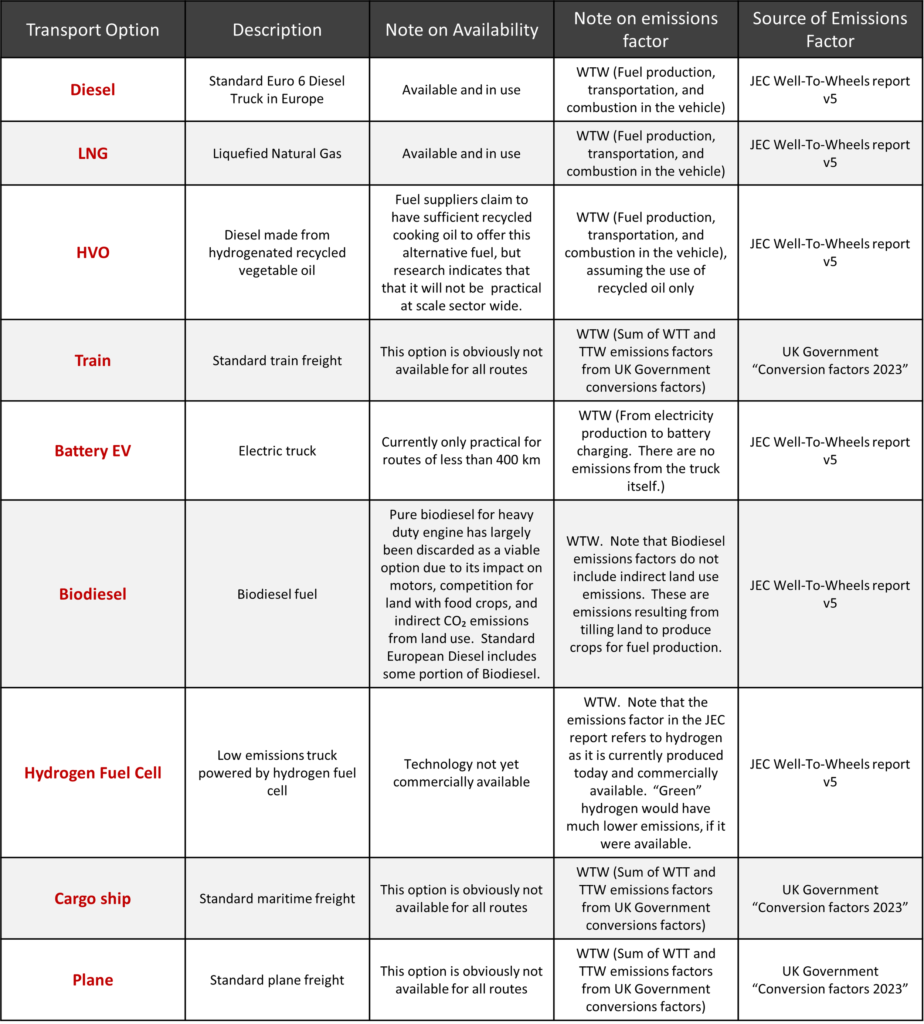CO₂ Calculator
Estimated CO₂ Emissions for Heavy Duty Road Transport
Step 1Estimated Emissions
Be sure to read the explanation and methodology below the table.
DISCLAMER
This calculator is meant to be useful to the customers of Furgo-Trayler. However Furgo-Trayler is not claiming that customers will necessarily achieve the results shown in this table as a result of using our services. The output shown by this calculator consists of projected estimates which should approximate the relative CO₂ reductions of each transport option. The data and calculations are based on well established Life Cycle Analysis data explained below, and on standard calculations. Real world results may vary.
Further Information on Transport Options

Explanation and Methodology
Calculation
Basic calculation: (Distance) * (MetricTonnes) * (EmissionsFactor) / (Conversion of g to kg) = Estimated total emissions in kg
Calculation demonstrating units: (km) * (t) * (gCO2e/t.km) / (1000g) = kgCO2e
Example: If distance is set to 100km and Metric Tonnes is set to 10 the estimated total emissions for diesel would be: (100km) * (10t) * (67.5gCO2e/t.km) / (1000g) = 67.50kgCO2e
Concepts
WTW stands for “Well-to-Wheels,” which means it counts all the CO2 from making the fuel to using it in your vehicle. In simpler terms, WTT (“Well-to-Tank”) is the CO2 made while creating and transporting the fuel, and TTW (“Tank-to-Wheels”) is the CO2 emitted when you drive.
LCA stands for “Life Cycle Assessment,” and it’s a method to evaluate the environmental impact of a product from its creation to its disposal. The “boundaries” in LCA define what stages are included in the analysis, like material sourcing, manufacturing, and end-of-life disposal. To compare data, you’d look at the environmental footprint of different products or services over their entire life cycle to see which one is more sustainable.
CO₂e stands for “Carbon Dioxide Equivalent,” a standard unit that converts the impact of various greenhouse gases into the equivalent amount of CO₂. This allows for a simplified, single number to represent the total climate impact of emissions from different gases.
t.km stands for Tonne Kilometers which is a standard unit when analyzing emissions or consumption in the transport sector. It combines the amount of material to be moved with the distance
References and Data Sources
Driving Distances in Spain
DriveBestWay.com. (n.d.). Distance Between Spain Cities and Places, Driving Distance Calculator, Driving Directions and Flight Distances on Map. Retrieved September 24, 2023, from https://www.drivebestway.com/mileage-chart-with-distances-between-cities/es/
Driving Distances in Europe
Engineering Toolbox. (n.d.). Driving Distances between European Cities. Retrieved September 24, 2023, from https://www.engineeringtoolbox.com/driving-distances-d_1029.html
Emissions Factors (Except for Train, Cargo Ship and Plane)
Joint Research Centre (JRC). (2020). JEC Well-To-Wheels report v5. Retrieved from https://publications.jrc.ec.europa.eu/repository/handle/JRC121213
Emissions Factors for Train, Cargo Ship and Plane
UK Government. (2023). Conversion factors 2023: full set (for advanced users) – updated 28 June 2023. Retrieved from https://www.gov.uk/government/publications/greenhouse-gas-reporting-conversion-factors-2023
